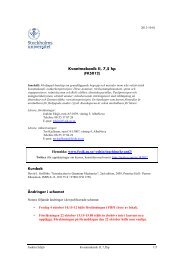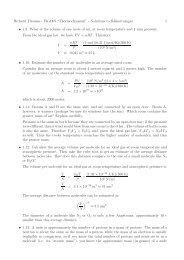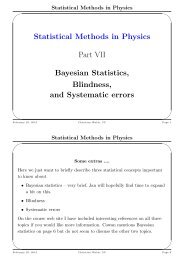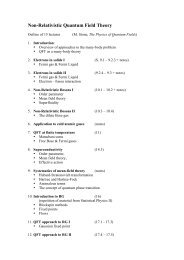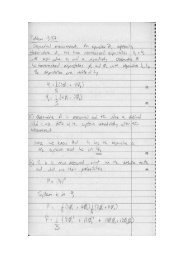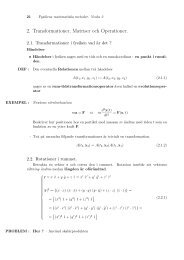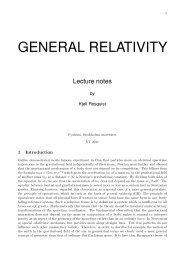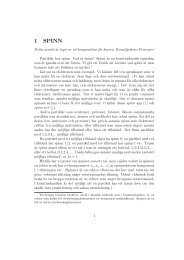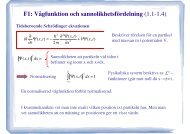Final Examination Paper for Electrodynamics-I [Solutions]
Final Examination Paper for Electrodynamics-I [Solutions]
Final Examination Paper for Electrodynamics-I [Solutions]
Create successful ePaper yourself
Turn your PDF publications into a flip-book with our unique Google optimized e-Paper software.
These admit plane wave solutions,<br />
E = E0e i( k·x−ωt) , B = B0e i( k·x−ωt) , with k 2 = µɛ<br />
c 2 ω2 .<br />
From the wave equations or from the solutions, one can read off the wave velocity<br />
in the medium as v = c/ √ µɛ. The index of refraction <strong>for</strong> electromagnetic waves in<br />
a medium is given by n = c/v = √ µɛ.<br />
b) For the above solutions, ∇· E = ik · E and ∇× E = ik × E with similar results <strong>for</strong><br />
B. Then the Maxwell equations ∇ · E = 0 and ∇ · B = 0 imply k · E = 0, k · B = 0.<br />
So E and B are perpendicular to the wave vector k. Now substituting the solutions<br />
in the remaining two Maxwell’s equations gives k × E = ω<br />
c B and k × B = − ω<br />
c E<br />
which proves that E and B are also perpendicular to each other.<br />
5. (a) Starting with Maxwell’s equations in the presence of sources, introduce the<br />
potentials A and Φ and rewrite the equations in terms of the potentials in the<br />
Lorenz gauge.<br />
(b) Write down the solution <strong>for</strong> A in terms of the spherically symmetric retarded<br />
Green’s function (the Green’s function need not be derived) <strong>for</strong> a localized<br />
source with a sinusoidal time dependence, J(x, t) = J(x)e −iωt . How does one<br />
characterize the Near, Intermediate and Far zones? Discuss the solution in the<br />
Near zone.<br />
Solution (points: 14)<br />
a) Let us consider the two homogeneous equations (the ones without sources). ∇· B =<br />
0 implies that one can always express the magnetic field as B = ∇ × A. Using this,<br />
the remaining homogeneous equation becomes, ∇×( E + 1<br />
c ∂ A/∂t) = 0, which implies<br />
the existence of a scalar potential such that E = − ∇Φ − 1<br />
c ∂ A/∂t = 0.<br />
Now we substitute these into the equations with sources. ∇ · E = 4πρ gives,<br />
∇ 2 Φ + 1<br />
c<br />
∂<br />
∂t ( ∇ · A) = −4πρ .<br />
The Maxwell equation sourced by J gives (on using ∇×( ∇× A) = −∇2A+ ∇( ∇· A)), <br />
∇ 2 A 1<br />
−<br />
c2 ∂2A ∂t2 − <br />
∇ ∇ · A + 1<br />
<br />
∂Φ<br />
= −<br />
c ∂t<br />
4π<br />
c J .<br />
The Lorenz gauge condition ∇ · A + 1(∂Φ/∂t)<br />
= 0 decouples these two equations<br />
c<br />
giving,<br />
∇ 2 Φ − 1<br />
c2 ∂2Φ ∂t2 = −4πρ , ∇2A 1<br />
−<br />
c2 ∂2A = −4π<br />
∂t2 c J .<br />
b) The solution of the above equation <strong>for</strong> A in terms of the spherically symmetric<br />
retarded Green’s function is<br />
A(x, t) = 1<br />
<br />
d<br />
c<br />
3 x ′<br />
<br />
J(x ′ ′ , t )<br />
ret<br />
|x − x ′ ,<br />
|<br />
5


![Final Examination Paper for Electrodynamics-I [Solutions]](https://img.yumpu.com/21085948/5/500x640/final-examination-paper-for-electrodynamics-i-solutions.jpg)
